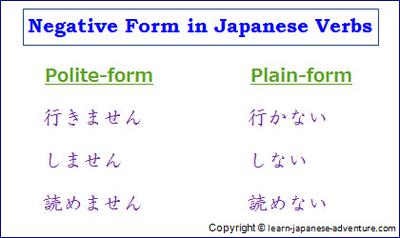- Home
- Learn Japanese Language FAQ
- In learning the japanese language, what does "negative form" mean?
In learning the japanese language, what does "negative form" mean?
by Erik Santos
(San Francisco, California, USA)

Negative form in Japanese Verbs
For example, when conjugating verbs, I somewhat get confused & I'm often corrected by others that I use the "rude form" of a verb.
Right now I'm learning about godan verbs, ichidan verbs, & the irregular verbs. Can you explain to me the form or types of forms there are (like when to use this type of verb in negative form and basically to explain to me what they mean by "negative form").
It's overwhelming learning present tense, past tense, formal form, etc.
Reply:
Hi Erik,
In Japanese, "Negative form" refers to negative answers in a sentence (or negative sentence). It has nothing to do with the "rude form" of a verb. For example, in English, we say:
1. I will go to America. (affirmative)
2. I won't go to America. (negative)
3. I play tennis. (affirmative)
4. I don't play tennis. (negative)
5. He can read Japanese. (affirmative)
6. He cannot read Japanese. (negative)
Therefore the "negative form" here refers to the negative answers (won't go, don't play, cannot read). In Japanese, the above examples can be translated as:
1. アメリカへ行きます。 (affirmative)
2. アメリカへ行きません。 (negative)
3. テニスをします。 (affirmative)
4. テニスをしません。 (negative)
5. 彼は日本語が読めます。 (affirmative)
6. 彼は日本語が読めません。 (negative)
I am using only verbs for the above examples. But it's the same for adjectives and nouns. For example...
1. Negative-form of the i-adjective おいしいです (delicious) is おいしくないです or おいしくありません (Not delicious)
2. Negative-form of the na-adjective 静かです (quiet) is 静かではありません (Not quiet)
3. Negative-form of the noun 先生です (teacher) is 先生ではありません (Not a teacher)
Plain-form (or rude-form)
As for the "rude form", I think you
In short, you use polite-form when you are talking to someone who you have met for the first time or not close enough, or to your superiors. It's considered rude if you speak in plain-form to these people...hence the name "rude-form".
You use plain-form when you are talking to family members, colleagues or close friends. It will seem strange to talk to them in polite-form.
Note: Godan verbs are Group 1 verbs, ichidan verbs are Group 2 verbs and irregular verbs are Group 3 verbs as explained in the lessons in this site.
If you apply plain-form on the above examples:
1. アメリカへ行く。 (affirmative)
2. アメリカへ行かない。 (negative)
3. テニスをする。 (affirmative)
4. テニスをしない。 (negative)
5. 彼は日本語が読める。 (affirmative)
6. 彼は日本語が読めない。 (negative)
In conclusion, I suggest you should learn the various forms one by one in the correct order so that you won't be confused. I would suggest that you first learn the polite-form of verbs, i-adjectives, na-adjectives and nouns. After that, proceed to learn the plain-form which is more confusing in my opinion.
Visit the following lessons under the "Related Pages" for further discussion on polite-form, plain-form, various types of Japanese verbs and how to form and use them, past tense of Japanese in polite-form and plain-form, etc.
Related Pages
Japanese Verbs plus Polite and Plain Styles.
Japanese Verbs - Dictionary-form and Nai-form.
Past Tense of Japanese.
Past Tense in Plain Form.
Hope this helps,
Kia Leng







